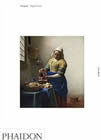Diana and her Companions
c. 1653–1656Oil on canvas
98.5 x 105 cm. (38 3/4 x 41 3/8 in.)
Mauritshuis, The Hague
Rembrandt van Rijn (1606-69), the most famous seventeenth-century Dutch painter today, was likewise known for quiet, meditative pictures, mostly executed late in his career. In fact, the poses of Bathsheba (fig. 1) and her elderly attendant from Rembrandt’s painting of 1654 display such striking affinities with Vermeer’s Diana that one wonders whether the young painter had seen it. Similar as well is Vermeer’s technique of modelling his figures with thick impasto and his application of brushstrokes that adhere to the contours of the folds of the figures’ garments. Like Rembrandt, Vermeer relied on the light yellow-brown priming layer of the canvas as an interactive agent with the paint layers above it, and he introduced subtle chiaroscuro to enhance the mood of the scene. These aspects of Diana and Her Companions probably explain the false monogram, 'N. M.,' the painting bore when it was auctioned in Paris in 1876: N. M. refers to Rembrandt's erstwhile pupil Nicolaes Maes (1634-93), to whom it was attributed and even falsely hailed as one of that artist's masterpieces.

Rembrandt van Rijn
1654
Oil on canvas, 142 x 142 cm.
Louvre, Paris

Carel Fabritius
c. 1645–47
Oil on canvas
Los Angeles County Museum of Art, Los Angeles
If Vermeer’s painting bears any relation to the work of Rembrandt or members of his so-called school, it was possibly because of his presumed acquaintance with Carel Fabritius. Fabritius’ history paintings (fig. 2) show techniques analogous to those of Rembrandt, with whom he studied between approximately 1641 and 1643. This might explain how Vermeer could have become familiar with Rembrandt's art, even if he had not actually seen the eminent painter's depiction of Bathsheba. Moreover, in their representations of mythology, both Fabritius and his younger colleague depicted unusual moments in what were otherwise standard tales.
The question of potential connections with paintings by Rembrandt and his followers aside, Diana and Her Companions reveals the hand of a somewhat tentative artist who had not yet developed a cohesive signature style. That Vermeer appropriated stylistic and iconographic devices from other artists may come as a surprise to some readers, because we live in an age that places such a high premium upon originality. All too often, this value is mistakenly projected backwards—all the more so in Vermeer’s case, because he is lionized today. Vermeer and his colleagues routinely studied each others’ pictures as well as those of long dead artists. Indeed, artists were expected to adopt each other’s techniques and devices. The intention, of course, was to create a work that would transcend its antecedents. The early seventeenth-century art theorist Karel van Mander (1548–1606) advises as much and records a saying probably well known among painters of that era: "Well-cooked turnips make delicious soup." This proverb contains a witty double entendre lost upon English speakers: the plural for 'turnips' in Dutch is rapen, a word also meaning 'to borrow' or 'to steal.'
The colors, particularly the red-blue-ochre scheme, still resemble those of Christ in the House of Mary and Martha. A certain fuzziness of contours and in the faces—not found in the latter painting—seems to anticipate The Procuress, where these effects are more pronounced. The brass basin (fig. 3), with its thick highlight on the rim, is more boldly painted and more subtle in effect than the vessel of Saint Praxedis (fig. 4). Vermeer further elaborated upon this handling and its realistic effects in the wine jug in The Procuress. On balance, Diana and her Nymphs can be placed most convincingly between these two paintings and should be dated around 1655–1656.
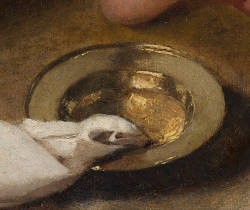
Johannes Vermeer
c. 1653–1656
Oil on canvas, 98.5 x 105 cm.
Mauritshuis, The Hague
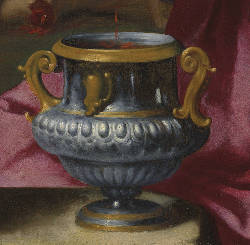
(attributed to Johannes Vermeer)
1655
Oil on canvas, 101.6 x 82.6 cm.
Kufu Company Inc., on long-term loan to the National Museum of Western Art, Tokyo
Vermeer painted another mythological subject, probably around the same time. The picture, Jupiter, Venus and Mercury, was listed in a sale in Delft in 1761 but has since been lost. As with the The Visit to the Tomb…, no description or visual record survives. However, a painting by Jordaens of this rare subject, taken from the ancient Roman poet Apuleius’s The Golden Ass, was in a Delft collection in 1652/1653, when Leonaert Bramer (1596–1674) drew a copy of it (fig. 5). It is speculative, though not implausible that Vermeer took inspiration from Jordaens’s work, all the more as its composition, namely the figures of Jupiter and Mercury and their interaction, bears resemblances with those of Christ and Martha in Vermeer’s painting.

Leonaert Bramer after Jacques Jordaens
c. 1652−1653
Black chalk on paper, 292 × 346 mm.
Cambridge MA, Estate of Seymour and Zoya Slive
In this evocative mythological painting, Diana sits with her companions near the edge of a dark and impenetrable forest. As evening falls she gazes unseeingly into the distance while one of her companions kneels before her, attending to her feet. The quiet and somber mood is unusual for depictions of this fleet-footed goddess, who, when not shown hunting with bow and arrow is often bathing with her nymphs splashing water upon Actaeon to transform him into a deer, or confronting the pregnant Callisto.

Johannes Vermeer
Vermeer has given Diana only one attribute, the crescent moon (fig. 6), that identifies her as goddess of the night. This role, symbolically associated with death, is central to Vermeer's artistic intention other pictorial elements reinforcing this theme are the thistle and geranium, symbols of earthily sorrow, and foot-washing, which in Christian traditions alludes to purification, humility, and approaching death. Probably because of this thematic connection Vermeer adapted the pose of Diana from Rembrandt's Bathsheba (fig. 1), 1654, where the Old Testament heroine sits contemplating the weighty implications of David's letter. Vermeer may have conceived his painting in response to a personal loss, perhaps the untimely death of Carel Fabritius in the powderhouse explosion of 1654.
The Italianate subject and style of the Diana, with its size and comparatively conventional facture, have inspired general agreement that it is a very early picture, perhaps the first by the painter that we have. In the case of Vermeer such indications are not always reliable. Certainly there is something in the picture, and particularly in the explanatory use of tone, which distinguishes it from the three pictures which have just been considered (Christ in the House of Martha and Mary, The Procuress, A Girl Asleep). The light falls gently and broadly across the form, making the subtlest modulation precisely apparent yet preserving most completely the unity of the whole. This comprehensive breadth is hardly approached again by Vermeer until the time of the conversation pieces. Some distance must lie between it and the bare tonal differentiation of The Procuress or the heavy flourish of The House of Mary and Martha. The point is clearer in photographs than when we are confronted with the polychromatic richness of the original. Perhaps it was the painter's intention to fabricate a conventional Italianate and especially, as Dr. De Vries has suggested, Venetian colour scheme. There is none the less much in the colour of the Diana, particularly in the combination of orange-pink and yellow, which points toward the early genre pictures. It seems that the dress of the attendant who dries Diana's feet, and perhaps the model who wears it, are the same which appear in the Girl Asleep. The two works may well date from the same phase. Possibly Diana and her Companions represents the culmination of Vermeer's wider ambitions. It shares the fundamental uncertainty of style in all the early pictures. The head of Martha, that of the standing nymph and the mirror in The Music Lesson tell the story of its resolution, and the development of the painter's surprising independence.
The picture was for a time ascribed to Vermeer of Utrecht. The signature was once altered to that of Nicolaes Maes; it is now completely obscured. Writers on the Diana have followed Bode in recognizing that the arrangement is based on a rendering by Jacob van Loo at Berlin (fig. 7). It seems that Vermeer was in fact familiar with more than one of the artist's versions of the subject (fig. 8); the attendant here whose cloak falls across her back, baring her shoulder, is a direct quotation from a picture which is now at Copenhagen. This is not the whole of the debt. The motif of Vermeer's chief figure has no analogy in either work and it can hardly be by chance that a precise parallel to it, even to the memorable fall of light upon the head, appears in a third picture by Jacob van Loo, a genre piece of a Young Couple in a Chamber (fig. 9). A Delft picture which has points of resemblance to the Diana, a mutilated canvas called The Minuet, was evidently suggested by the same work. It provides a further indication that even the more remote of Vermeer's sources were equally available to other members of his circle.

Jacob van Loo
1648
Oil on canvas, 136.8 x 170.6 cm.
Staatliche Museen zu Berlin, Preußischer Kulturbesitz, Gemäldegalerie
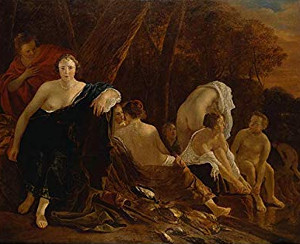
Jacob van Loo
c. 1650
Oil on canvas, 162 x 199 cm.
Herzog Anton Ulrich-Museum, Brunswick

Jacob van Loo
c. 1650
Oil on canvas, 71.3 x 66.8 cm.
Mauritshuis, The Hague
There were other currents to confirm Vermeer's choice of subject. In 1654 Rembrandt designed just such a pose and action for his Bathsheba. It appears that the Diana had some influence on the later treatment of such subjects. The picture was a link between the Italianism of the first half of the century and that of the decline; no doubt its example contributed something to the arrangement of the little Venus of Frans van Mieris, one of the first of the mythological panels which became a staple product of the family. From Vermeer's own world the Italianate and pastoral style was now cast out. It does not appear again until, according to the habit of condensation which is typical of his thought, similar figures in the manner of Jacob van Loo are seen at last extending their elegant limbs in the Finding of Moses which appears behind the Beit Letter Writer, a picture hanging on the wall.
The episode in Ovid's Metamorphoses depicted in Diana and Her Companions occurs just before the climax of the story. The nymphs are resting in a bosquet near a spring. Some are beginning to undress the goddess or to throw water at her feet. Suddenly Acteon, hunting with his dogs, discovers the sacred group. Diana attempts to avoid his stares at her nakedness by shielding herself with the bodies of her attendant nymphs. She then splashes water at the head of Acteon and hurls an imprecation at him. Through her divine power, he is at once metamorphosed into a stag. Later the unhappy youth is devoured by his own dogs. The moral of Ovid's tale: the voyeur has received the punishment he deserved.
Between the dog and Diana in Vermeer's painting, a conspicuous thistle is outlined against the more brightly lit side of a large rock. The prickly plant traditionally symbolizes the male element, as in Frans Hal's famous marriage portrait (fig. 10) in Haarlem. It is absent in Van Loo's painting. The thistle suggests the impending presence of Acteon, the protagonist of the scene. The idea of hinting at the nearby presence of a protagonist will often recur in Vermeer's mature art. In this particular case, the formal absence of Acteon from the scene contributes to the mysterious aura of the painting, in contrast to the earlier tradition of representing Acteon spying on the goddess and her nymphs or happening upon them.
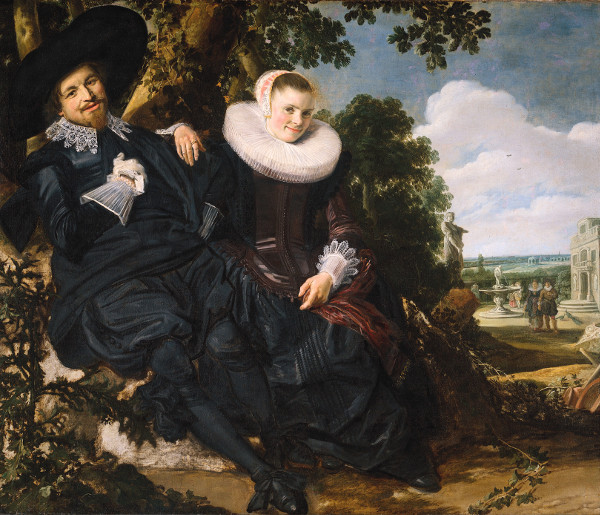
Frans Hals
1622
Oil on canvas, 140 x 166.5 cm.
Rijksmuseum, Amsterdam
